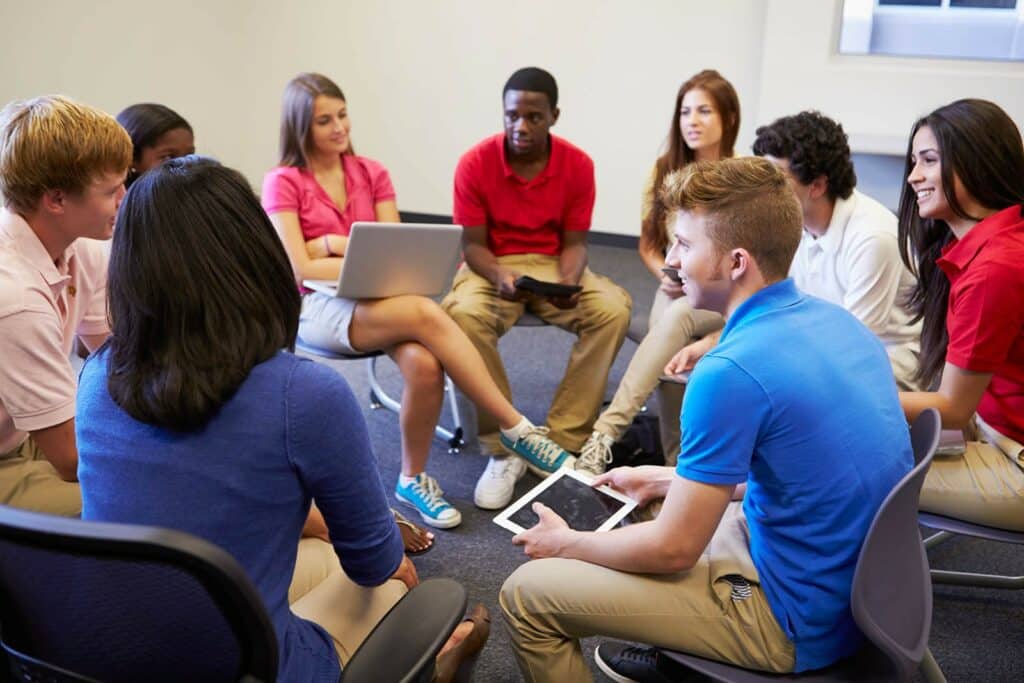- The Cognitive Learning Theory focuses on understanding the internal mental processes in our brain that are involved in learning.
- According to the Cognitive Learning Theory, both internal and external factors can impact our learning and performance.
- Cognitive learning strategies can help us create a great learning environment that encourages students to be more confident and promotes a love of learning.
Most of us have used repetition and memorization when studying for exams. But those learning strategies are not always effective when building knowledge (although some memorization methods are better than others). You have probably noticed how difficult it was to recall everything you memorized long after the exam was over. According to the Cognitive Learning Theory, it is only when we truly understand how our thought process can affect learning that we can gain knowledge effectively.
The Cognitive Learning Theory focuses on how our brain processes information in order for learning to occur within an individual. In layman’s terms, it talks about what goes on inside your head when you learn something. Today, we’ll look at what cognitive learning is, its numerous advantages, and how it can be applied in both offline and online learning.
Table of Contents
What is Cognitive Learning Theory?
The Cognitive Learning Theory was first developed in 1936 by Jean Piaget, a psychologist who studied how infants and children learned. He didn’t fully agree with the Behaviorist Theory – the most widely accepted learning theory at the time. According to Behaviorism, one can only objectively measure observable behavior. We cannot see what happens in someone’s mind, so we cannot scientifically study it.
But Piaget argued that we can, in fact, understand the internal mental processes inside our brain that respond to stimuli and cause behavior. In fact, based on his research, he discovered that children are active participants in their learning process, and that they use their existing knowledge to construct new knowledge.
Over the years, many cognitive scientists have agreed with this. It’s not enough to just study behavior to understand how learning occurs. How our brain receives, interprets, stores, and retrieves information is all part of the learning process. When we understand how our brain works, we can optimize the cognitive processes to make learning easier and more effective.

Metacognition
The basis of understanding cognitive learning is by knowing what metacognition is. Metacognition, or “thinking about thinking,” can help you understand how our mental processes work and how they are influenced by external factors.
So, what is metacognition? In simple terms, metacognition is all about being conscious or aware of your thoughts, feelings, and mental processes and how they relate to your current performance. This means reflecting on your ability to learn, how you learn, what you know and what you don’t know, and how these factors affect your quest to build knowledge.
Here’s a real-life example: Let’s say you’re reading a book. Once you finish reading a part of the text, you feel that you don’t understand the information that you just read. This awareness is metacognition. And because you are aware, you will try to remedy your lack of understanding by rereading it again.
Here’s another example: You took an exam, and the teacher just returned your test paper. You look over the corrections and ask yourself where you went wrong. You determine what you currently know and don’t know. Because of this reflection, you are able to ask your teacher specific questions that will help you gain the knowledge that you’re missing. This is how metacognition can be used to promote learning and achieve academic success.
According to the Cognitive Learning Theory, there are three components of cognitive learning – comprehension, memory, and problem-solving or application.

Two types of Cognitive Learning Theories
There are two types of cognitive learning theories. These two theories are closely connected and explain how internal (thoughts and feelings) and external (what we see) can affect how we learn.
The Social Cognitive Theory states that we learn in a social context, and our learning is influenced by us, our environment, and our behavior. Simply put, our ability to learn and perform can be affected by our thoughts and external factors. For example, little kids in preschool are told that if they follow their teacher’s instructions, they can get a stamp or a sticker. This gives them motivation to follow the instructions.
The Cognitive Behavioral Theory, on the other hand, states that our behavior is dictated by how we think and feel. For example, you find yourself struggling to understand math concepts. So, you end up thinking that maybe you’re dumb or just aren’t good at it. In math class, you feel frustrated and angry, which inevitably affects your performance.
Benefits of the Cognitive Learning Theory
- Cognitive learning enhances comprehension. You can gain a deeper understanding of new concepts by questioning what you learned, how you learned, and what else you don’t know.
- Cognitive learning is not about rote learning, where you memorize information instead of comprehending it. Instead, it helps you determine the most effective way for you to learn. For educators, it’s a way to help them find their students’ learning styles.
- Cognitive learning improves problem-solving skills. It teaches you to analyze your thought process and look at where you went wrong.
- Cognitive learning boosts confidence. You gain problem-solving skills as well as a deeper understanding of your abilities and how you learn. This makes you more confident when learning new things.
How do you apply the Cognitive Learning Theory in the classroom?
Now that you understand the cognitive learning theory, it’s time to apply it in the classroom, whether it’s face-to-face or online. Below are some strategies that teachers can use to help create an environment conducive to cognitive learning, whether online or in person:
1. Foster self-reflection
As we’ve mentioned before, the basis of cognitive learning is “thinking about thinking.” Students need to evaluate their mental processes. As a teacher, you should give them different opportunities to self-reflect. You can ask them to journal about what they’ve learned. Alternatively, you can give them some quiet time before initiating a discussion on their self-analysis.
2. Model behavior
Students, even the old ones, can learn by observation and imitation. In fact, even those who are no longer students still apply this cognitive learning strategy. Who hasn’t tried learning a new skill by observing an expert? As a teacher, you should try thinking out loud in front of your students. This demonstrates your problem-solving skills, which they can later imitate. Of course, it’s also important that you give them opportunities to practice what they learned.
3. Provide opportunities to make mistakes
Let your students practice their learning by giving them a hands-on problem to solve or through a simulation. Aside from the fact that application enhances learning, allowing them to make mistakes can teach them what they misunderstood or didn’t know. More importantly, errors can help them see the flaw in their thought process, which they can correct, enabling them to avoid making the same mistake in the future.
4. Ask questions
Aside from giving students opportunities to question themselves, you can also help them gain a deeper understanding of a concept by asking them questions based on their responses. Your questions, in turn, can help them analyze what they have learned, allowing them to dive deeper into their thought process. In an online class, you can use social media to pose these questions and ask students to place their answers as comments on your post. These questions can also be sent via email to make them feel safe from external judgments.
5. Facilitate group discussions
Don’t just let students respond to your questions; allow them to ask questions amongst themselves. Give them opportunities to share their opinions on the topic as well as their experiences. Because online learning can include self-paced programs, it’s not always easy for the students to gather online and have a live discussion. To address this problem, create an online forum where students can leave questions, give feedback, and share their experiences.
6. Create content that suits their learning styles.
We all learn differently. Make sure that your students have access to different mediums to cater to their way of learning. For example, you can provide the lesson’s main ideas in bullet points with links to online sources that students can use such as videos, audio files, articles, etc. Your students will then have the opportunity to explore the content further using the medium of learning that is most effective for them.
Other cognitive learning activities
Apart from creating a great learning environment for your students, here are some examples of cognitive learning activities that you can use in the online and offline classroom:
- Ask your students to create graphic organizers, which are visual diagrams that show the relationships between ideas. Some examples of graphic organizers are charts and mind maps.
- Have your students write a play about historical events from memory.
- Hold a debate where your students need to defend a point of view.
- Pair students together and let each teach the other a new concept.
- Tell your students to create a questionnaire to test their understanding of the lesson.
- Instruct your students to write a list of real-world applications of the knowledge that they’ve just learned.

Conclusion
Knowing how our mind works helps us understand how we acquire new information. By understanding the Cognitive Learning Theory, we can improve the way our students receive, process, and retain new information. Letting them become an active participant in their learning process makes the experience more effective and memorable. More importantly, we can help them develop their full potential and live a life of continuous learning.



